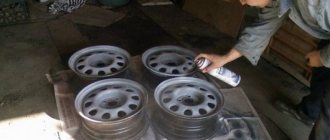As practice shows, most car owners suffer from a lack of power in their “iron horses”. In this case, tuning will help solve the problem. It represents a change in the engine and transmission, resulting in an increase in engine power characteristics. Real fans, when modifying a car, often spend more money than the car itself is worth. The changes affect absolutely all systems and components.
To increase the power of a car, it is not necessary to completely tune the car. It will be enough to improve a certain system, which will give an increase. Perhaps one of the most common types of tuning is the installation of a direct-flow muffler. The result is increased engine power and a pleasant, powerful exhaust sound. Thanks to this, an ordinary car becomes like a sports car. This is why many people decide to make such modifications.
Sports muffler - do-it-yourself exhaust tuning
Fans of auto tuning are ready to endlessly carry out “experiments” on their car, just to somehow stand out from the crowd, but the first thing that changes in the device is the installation of sports mufflers. Any intervention in the design of standard machine systems must have a clear justification and be carried out in compliance with certain technologies and rules. When starting to modernize components such as the exhaust system, you should know exactly what the final result should be and how to do it correctly.
Sports muffler - main differences from the serial one
The final goal of any auto tuning is to give the car special expressive features, which relate to the appearance, interior design, and changes in engine operating parameters. Of course, the exhaust sound should also be changed to a more solid one. A car enthusiast who can distinguish between a sports car and a regular one only by the bass growl of the exhaust can visit a specialized auto store and buy a muffler attachment that will change the sound.
If you have an irresistible desire to manufacture and implement an exhaust system, exactly the same as on sports cars, you will have to work hard. First of all, you need to understand how standard exhaust systems on production cars differ from those cars that participate in racing.
For a sports car, it is very important that the engine operates at full power. One of the factors that robs an engine of several horsepower is the presence of resonators and mufflers in the exhaust system.
Direct-flow exhausts are installed on motocross cars. This suggests that the gases, leaving the combustion chamber, rush into the atmosphere through a pipe that has no obstacles inside. On the one hand, this allows for very effective ventilation of the combustion chamber. On the other hand, the absence of “barrels” allows the sound of the engine to escape in its original form.
For those around, the roar of the engine turns out to be uncomfortable; drivers and navigators protect their hearing, but the engine can show the maximum of its capabilities. When thinking about how to make a sports muffler, you should not completely imitate sports technologies. Minor changes can add bass and power without annoying everyone in or around the car.
Car enthusiasts have three options for tuning the exhaust system in the “sport” style:
- purchasing a ready-made muffler at a car store;
- manufacturing a muffler from scratch;
- modernization of the existing exhaust system.
Since new tuning parts are quite expensive, and independent development and production of an exhaust system takes too much time and effort, you should try to change the muffler that is already installed on the car.
How to make a sports muffler - step by step instructions
The desire to make your car more beautiful, faster and more stylish obliges the car enthusiast not only to acquire a set of special devices and accessories, but also to master the basics of metalworking.
In addition to the standard set of automotive tools, you must have:
- an angle grinder (grinder) with a set of discs;
- welding machine (preferably semi-automatic);
- appropriate protective clothing, hand and face protection.
In order to make a sports muffler with your own hands, you need to make minor changes to the design of the muffler. The resonator should not be touched, since it does not have a decisive influence, and itself is partially direct-flow. The muffler inside is designed like a labyrinth system, which finally extinguishes the inertia of the gas, creating a certain pressure in the exhaust pipe and significantly suppressing low-frequency sound vibrations.
Sports mufflers for VAZ of any series are made in a simple way:
- the muffler is removed from the car;
- using a grinder, cuts are made in the lower part of the body so that the inside can be completely opened;
- all pipes and partitions are removed from the muffler body;
- inside the housing, the inlet and outlet are connected by a piece of pipe of the appropriate diameter, in the walls of which there are holes or slots in the form of a sieve;
- the void around the pipe is filled with basalt wool;
- the muffler body is closed and welded;
- welds are cleaned;
- The muffler is painted with heat-resistant paint.
With this design, the muffler receives a direct flow of gases, and the cotton wool helps dampen high and medium frequency sounds. As a result, the exhaust gets a low, velvety tone in a sporty style, but thanks to the preservation of the resonator, it remains acceptably loud, at least at low crankshaft speeds.
Sports mufflers are good
The desire to roar the engine arises when there are spectators who can appreciate such technical sophistication. The continuous roar “overboard”, which breaks through with irritating vibration into the cabin, is tiring. In order to reduce the noise level if necessary, you can use special attachments. In stores you can find muffler attachments that not only change the sound, but also make it much quieter.
Another point that should be remembered when installing a direct-flow exhaust is the need to adjust the fuel and air supply system. Removing internal obstacles to gas inside the muffler will necessarily entail an imbalance in the air-fuel mixture supply system. To set it up, you will have to contact specialists.
Communities › Kulibin Club › Blog › Intake/exhaust: Juicy exhaust with your own hands!
Good day!
In any car, the exhaust sets the mood of the driver when you start the car and when you give it gas, but you also want to be able to drive calmly and so that the exhaust does not bother you with its noise... in a word, you need something like that... in a word, the task is not an easy one... Initially, the victory there was an original muffler: This can has a relatively small size and there is an inlet and an exit on one side, and the saddest thing about this whole thing is that in the back there is only room for such a can in captivity of size, and in the configuration pane there should also be an inlet and an exit On the one side…
Therefore, I decided to go the not very popular route))) to make the jar myself! There are only three goals: 1) Make a pleasant sound 2) Make everything fall into place 3) So that the whole idea turns out to be budget-friendly In short, this doesn’t happen, but I’ll try! I didn’t make a complete can; I decided to remake it from any car that would fit the size. After a short search, it turned out that the size of the can is very similar to that of a regular carburetor Niva, and its price tag is VERY humane, in short, you don’t mind if you ruin something)))
Next, I decided to saw through my own can from the victory and from the Niva to see their structure, the only thing from the Niva was that I needed to carefully cut it so that it would be easier to cook later.
What immediately caught my eye was that the jar that was made 60 years ago was assembled to a much higher quality than they make now. Well, actually, you need to make a can for victory out of a Nivov can, but with a pipe diameter of 63. As a result, there is a lot of information on the Internet and after reading wise books about how exhausts are made, in the end I was convinced that they used to approach these matters more seriously than now on the vase)) ) In short, I sketched out a drawing and will do it this way.
I took the design of the silencer from Victory as a basis, but changed it a little, larger pipes, added a section with padding, and slightly changed the last partition.
Full video of construction and testing:
One of the necessary things that I needed was perforated pipes, you can buy them, but we do it for free, so it takes a LONG time to drill a simple pipe
Uvot assembled on the table wakes up something like this
Next we make a zone with padding. For reference, gases do not flow through the packing! it is needed for other purposes, namely to dampen mostly high frequencies, i.e. so that we don’t have a sound as if someone attached a pan to the car and it’s clanking, this very often occurs on gazelles and Volgas, this pan ringing. I don’t need this ringing! We have two components for the packing: 1) stainless steel wool, sold in exhaust stores
2) basalt wool, sold in construction stores
At the end I put a dividing partition that I made from the partition from the current Niva muffler, finishing it off a little.
the end result was a pretty neat jar
then the entire exhaust was filled with heat-resistant paint and that’s it!
As a result, the result was achieved by 100%! The sound turned out excellent (there is a video) Everything fell into place And the price tag is simply unrealistic for such a result... Thank you all for watching!
Do-it-yourself exhaust system tuning
Every car has an exhaust system. It serves to remove exhaust gases and dampen sound vibrations. The design of the system may vary, depending on the type of engine and year of manufacture of the car. Also note that the exhaust is often subject to tuning. Many motorists are trying to modify it: some with the aim of changing the sound, and others with the aim of adding a small amount of power. How to tune the exhaust system with your own hands? Let's look at it in our article today.
Is it possible to adjust the exhaust volume
To make an adjustable muffler with your own hands, just connect the forward flow to the throttle valve. When closed there will be a quiet sound, and when open there will be a loud “growl”. The degree of bass can be adjusted using a choke cable from the GAZ-53.
More detailed work on the throttle is carried out using a pipe with a diameter of 50 mm and a 46th throttle:
- The axle and valve are pulled out of the throttle.
- A through hole is drilled in the pipe to match the diameter of the axis.
- Brass bushings are machined and pressed into metal frames.
- The frames are attached to the pipe.
- Additionally, a choke drive from the carburetor is welded to this structure.
- The finished damper is welded into the resonator from the muffler side.
- The second end of the carburetor cable with a button is fixed in the cabin between the seats.
When you need to turn on the forward flow, just pull the cable.
On what cars is this possible?
You can tune this system on any car. But, as a rule, they experiment with it on domestic cars. And it’s not just cars. Tuning the Patriot exhaust system is a fairly common occurrence. Oddly enough, a forward flow is also installed here and other improvements are made.
Very often, tuning the exhaust system begins with the exhaust manifold. So, “Spider 4-2-1” is installed on four-cylinder cars. This is done to increase power. But as experts say, you can only get a slight increase, and even then only at the “top.”
Among the most popular manufacturers it is worth noting:
It is very difficult to make a “spider” yourself, unlike a muffler (we will talk about its manufacture a little later). When choosing a “spider”, it is important to pay attention to the presence of an oxygen sensor in the standard system. If present, it must be transferred to the new exhaust manifold. For this purpose, some models already have standard cutouts for these sensors.
How does the installation work? To do this we need a standard set of tools:
- Open-end wrenches and sockets.
- Grease VD-40.
- New manifold gasket and new bolts.
Work should be carried out in an inspection pit. It is very difficult to reach the exhaust system using a jack, so we exclude this option. So first of all we need to remove the old exhaust manifold. Often old bolts stick and rust because they heat up and are located in the lower part of the body. They must first be soaked in WD-40 and then unscrewed. Sometimes it happens that the threads break off along with the bolts. Therefore, you should always keep a set of new ones on hand. It is advisable to install them later. You should also unscrew the bolts securing the exhaust pipe. Next, you can remove the collector.
Our sports “spider” should sit on standard studs, without modifications. Installing it is done in reverse order. The top part is attached first, then the rest of the exhaust system is connected. Tuning at this stage can be considered complete. Be sure to install a new gasket, as the old one will not provide the same seal.
Thermal tape
This is another fairly common option for tuning the exhaust system of Audi and many other cars. What is its essence? The exhaust manifold gets very hot, and to prevent its walls from cooling down, the outer part is treated with thermal tape. Thus, at a consistently high temperature, gases will better leave the surface of the pipes, without turbulence. In total, the collector will take about five meters of such tape. It is wrapped in a spiral, as in the photo below.
Let's sum it up
Tuning the exhaust system will add power to the car's engine and originality to its appearance. And also the excellent sound of the car will attract the attention of those passing by. However, upgrading will cost you a significant amount of money, even if you can do it yourself, and will increase fuel consumption. Before you get started, weigh the pros and cons.
If you are one hundred percent confident in your technical knowledge and capabilities, then feel free to get to work. The updated exhaust system of the car will delight you with its improved characteristics.
Catalyst replacement
Another tuning method that has become widely used on injection VAZs is installing a straight pipe or flame arrester in place of the catalyst. The fact is that the latter has a dense structure inside and prevents the free escape of gases. Installing a flame arrester is simple: the old catalyst is cut out and a tuned element is welded in its place.
It is important that its diameter at the outlets matches or is not shorter than the receiving pipe and resonator itself, between which the welding is carried out.
Definition
Direct flow (or direct-flow vehicle exhaust system) is a system for removing exhaust gases from an engine, which does not have a large number of exhaust suppression and purification chambers (often only one “flame arrester” and one resonator are used), due to which the gases flow almost unhindered, without meeting There is virtually no resistance along the way. Moreover, they try to make the outlet pipe straight, without unnecessary corners and branches, in order to further reduce the resistance of the structure - hence the name “forward flow”.
Muffler tuning
Owners often want a louder, sportier sound from their car. This can be achieved by installing a direct-flow muffler. Its design does not imply the presence of partition walls. Accordingly, gases will leave the system more freely. This will make it easier for the engine to “breathe” (the cylinder blowing will increase).
You can make such a muffler from a factory one. What do we need for this? You should prepare:
- Bulgarian.
- Drill.
- Welding machine.
- Discs for cutting metal.
- A pipe of suitable diameter (if this is tuning a VAZ exhaust system, this figure is 52 centimeters).
- Iron sponges for washing dishes (at least 50 pieces) or glass wool.
So, we remove the factory muffler and use a grinder to open its body. Next, we dismantle all its insides. After this, we make tree-shaped cuts along the entire perimeter of the new pipe. The length of the latter should be such that it fits in the body of the old muffler. By the way, holes can also be made using a drill.
The new pipe is welded to the remaining tails for welding. The remaining space must be filled with dishwashing sponges or glass wool. Next we close our cut out body. It needs to be brewed well so that gases do not leak through the seam. If desired, you can paint the muffler silver.
This completes the tuning of the exhaust system. Afterwards you can install the structure in place. Externally, such a muffler will look like a standard one. But at engine speeds above 3 thousand per minute, the car will make a loud and bassy sound.
Types of tuning
There are several types of muffler modifications:
- audio tuning is intended for those who want to make the muffler on a car quieter or louder - usually done by installing a flame arrester instead of a neutralizer and adding forward flow;
- video modification improves the external design and is most often carried out using decorative attachments - does not lead to high costs and complete disassembly of the exhaust system;
- “dragon tongue”, when a flame comes out of the exhaust pipe during re-gassing - this is serious work on the design.
Making a sports muffler from scratch
Tuning the exhaust system can be done from scratch. For this we need:
- Two flanges for pipes (can be ordered from a turner).
- The pipe itself is at least 42 centimeters long.
The diameter of the pipes must be different. The outer one has a diameter of 13 centimeters, and the inner one is the standard 48 millimeters for a VAZ. If you are tuning the UAZ exhaust system, then this size is larger - 52 centimeters.
So, we take our perforated pipe and wrap it with non-flammable material. It could be asbestos. Next, install a large pipe and tightly fill the interior space with glass wool. After this, we use a welding machine to make seams on the front and back. It is important that everything is sealed. Next, we weld a hook for attaching the muffler in the bumper area. This hook should be both on the muffler itself and on the body. To secure it, you can take a regular rubber muffler cushion from a GAZelle. After this, you can safely install the element in place.
What is a straight-through muffler
Many people have sometimes noticed how tuned cars roar along the highway. What gives them extra power, a deep roar and instant acceleration? Improved exhaust system, namely the installation of a direct-flow muffler. Do not underestimate the exhaust system, because by changing its configuration, you can “play” with the power of the power unit without spending money on complex and expensive tuning of the gearbox or engine. You can make a direct flow in the garage, having a small set of tools with you; installing it is also not particularly difficult.
What is a direct-flow muffler, how does it differ from a regular one? This is a muffler in which the so-called “labyrinth” system has been removed in one of the resonators, due to which the exhaust gases escape faster than on a standard muffler. Installing direct flow is more than justified if the car has a tuned power unit. A more powerful engine produces more exhaust, so it is very important that the exhaust system does not “suffocate” it.
Installation of forward flow at a service center
Have you found out how to make the exhaust sound bassy (perhaps you found additional information on thematic motorist forums), but are not ready for tuning yourself or do not have the technical ability to do it? We recommend contacting specialists - a service center. We will carry out the necessary work on dismantling and installing direct flow in the car. We have a large database of components, experienced craftsmen and a polite approach to customers. Sign up for tuning in St. Petersburg by calling the contact number listed on the website. We serve clients who have pre-booked an appointment with a specialist from 10:00 to 23:00 (others until 19:00). Call us - we will advise you on issues related to the modernization or repair of mufflers.
The difference between a direct-flow muffler and a conventional one
A straight-through muffler is the same muffler, but without baffles to dampen low-frequency noise. It may contain mineral wool padding, which dampens high-frequency noise but allows low-frequency noise to pass through.
The diagram shows that the direct-flow muffler has no transverse partitions
A standard muffler consists of a rather complex system of pipes and grilles in which noise is dampened. Parts of the exhaust system on a modern car also include a lambda probe, a catalytic converter, and an exhaust gas temperature sensor. Thus, a standard muffler compared to a forward flow muffler is a slightly more complex system.
Direct-flow muffler device
For proper tuning of the exhaust system, it is advisable to install a different, improved exhaust manifold in combination with forward flow, remove the catalyst and install a receiving pipe of increased diameter. After all, in a tuned exhaust system, all obstacles that stand in the way of exhaust gases have been removed.
A straight-through muffler is made so that its throughput is higher than that of a standard muffler, and it more freely removes exhaust gases from the engine. As a result of such tuning, cylinder purging improves, less carbon deposits on the pistons and valves, which, in turn, increases the life of the power unit. Its power increases by about 15%.
A related factor is a slight deterioration in noise performance compared to the standard muffler. The straight-through muffler has a harsh roar that can attract the attention of the traffic police, cause a fine, or provoke the anger of neighbors when a tuned car revs under their windows early in the morning.
When installing an improved exhaust system, these factors should also be taken into account, otherwise tuning may cause pointless costs in the future. The absence of internal partitions and noise-absorbing padding makes direct flow relatively simple to manufacture.
What does direct flow give?
A significant improvement in the power performance of a car with the installation of a direct-flow muffler occurs when the power unit is fully operational, maintains normal compression, is little worn, and even better - if any of its components have been modified. Thus, forward flow will increase power if the cylinder head, the intake system have been tuned, or the cylinder block itself has been bored to a larger volume. If the car owner has not yet taken on serious modifications to the engine, but wants to spend money on exhaust tuning, then by doing so he will still increase the power of the power unit, receiving in addition a bass rumble, making the car a little more dynamic.
The filling of the cylinders with the air-fuel mixture depends on the nature of the exhaust gases. However, changing the sound in a “sporty” direction is sometimes enough for a car enthusiast, as it gives the car a certain style. It is worth moving on to any change in the design of a car with the utmost seriousness, since all systems and assemblies in it are interconnected. If you do not properly modify the exhaust system, you can end up with a very roaring car, the ride in which will become unbearable for both the driver and passengers.
Noise standards and liability for exceeding them
Responsibility for loud exhaust from a muffler is provided for under Article 8.23 of the Code of Administrative Offenses. The driver is charged for operating a vehicle with excess noise levels in accordance with the Technical Regulations of the Customs Union 018/2011 “On the safety of wheeled vehicles”, paragraph 9.9.
Table: dependence of the maximum permissible sound level on the vehicle category
| Vehicle category | Sound level (in decibels) |
| M1, N1, L | 96 |
| M2, N2 | 98 |
| M3, N3 | 100 |
Category M1, N1 and L are passenger cars with no more than 8 seats, trucks with a permissible maximum weight of no more than 3.5 tons, motorcycles/mopeds/ATVs. Category M2 and N2 are cars with more than 8 seats (except for the driver), but whose maximum weight does not exceed 5 tons, and trucks with a permissible maximum weight from 3.5 to 12 tons, respectively. Category M3 and N3 are full-fledged buses and trucks with a permissible maximum weight of more than 12 tons (trucks, most dump trucks).
According to 12.5.1 of the Code of Administrative Offenses, the driver (or owner) is charged for making changes to the design of the car without the permission of the supervisory authority - the traffic police.
So, the fine for a straight-through muffler can be either a warning plus a fine of 500 rubles, or two fines of 500 rubles each (in practice, two warnings cannot be issued).
The manufacture of a direct-flow muffler and its further improvement is within the power of most car enthusiasts. Despite the restrictions on the operation of such devices in our society, there are more and more people who want to make their own and install a direct-flow muffler on a car. Thanks to detailed instructions with photographs and videos, it will be much easier to make a forward flow.
How to make a direct-flow muffler with your own hands
Direct-flow mufflers are produced and sold freely, in different configurations, for many brands and models of cars. Different price categories and the price-quality ratio are of concern to everyone who decides to change the exhaust in their car.
Budget versions of direct flow systems may not only fail to improve power characteristics, but may also cause harm. Most often, they are made of thin metal, which, due to the external environment, humidity and aggressive combustion products contained in the exhaust gases, will fail faster than a standard muffler. A high-quality forward flow from a well-known tuning studio or simply made from durable materials will be very expensive.
The average car owner should think about creating a direct flow with his own hands, especially considering that it does not require too much material and time expenditure. All you need is materials, tools and patience with perseverance.
There are several ways to create a forward flow:
- remake the standard system, removing “unnecessary” from the point of view of the car owner;
- weld from high-quality, self-selected metal, direct flow of any shapes and sizes.
However, you will have to think through many points - from the length and diameter of the pipes to the methods of mounting the muffler and vibration damping methods. Let's consider a method for producing a direct-flow muffler from an old, standard muffler.
A drawing of a direct-flow muffler, suitable for domestic cars, can serve as the basis for making your own direct-flow muffler
What tools will you need?
To make a direct flow, you will need tools, access to electricity, and personal protective equipment. When working with a welding machine and metalworking tools, you should protect your eyesight and limbs.
- angle grinder "grinder";
- automatic or semi-automatic welding machine;
- drill with a set of metal drills;
- measuring instruments - ruler, caliper
Materials for making direct flow
Having collected the necessary tools, you need to purchase materials. The main ones will be:
- the standard muffler is in good condition, since a burnt-out muffler is not worth “tuning”;
- sections of steel pipes of suitable diameter and thickness;
- filling material - mineral wool, asbestos sheet, sometimes many brushes are used for washing dishes;
- A high-temperature muffler sealant may come in handy; it is sold in car dealerships;
- rubber mounting pads;
- optionally, if you are planning to paint the muffler, use high-temperature enamel.
Having made sure that all materials and tools are ready, we can begin production of a direct-flow muffler:
The standard muffler must be free of holes and burnouts
- Having inserted the prepared notched pipe into the gap between the inlet and outlet pipes, we weld it, monitoring the quality of the seam. The pipe needs to be welded around its entire circumference.
Seams must be welded thoroughly
We clean the insides of the muffler from everything unnecessary, remove the burnt-out packing, cut off the intake and outlet pipes so that small parts of them remain from the inside.
Muffler with cut out intake and exhaust pipes
- Using a grinder, we make a rectangular cut, removing part of the muffler wall so that its contents become accessible.
- We cut off the pre-prepared pipe so that its length fits clearly between the intake and outlet pipes in the cut muffler.
- Using a grinder, we make many cuts, or using a drill and a metal drill, we perforate the pipe along its entire length to make a “sieve.”
The pipe should be perforated with a drill or grinderWe fill the muffler with mineral wool. You can start by wrapping the inner pipe with asbestos cord. Instead of mineral wool, it is permissible to use steel or a variety of metal sponges for washing dishes. The padding should be tight.
Mineral wool is used to fill the muffler - We put the cut section back and weld it, carefully, avoiding lack of penetration or burning of the metal.
- We weld a tip, a “nozzle,” to the end of the outlet pipe.
- We clean the resulting sealed seam with a grinder.
- Those who want to protect the muffler from the external environment for longer can paint it with high-temperature enamel, after thoroughly cleaning the surface and degreasing it.
The muffler is ready. You can install it on your car, enjoy the bassy sporty sound and improved power characteristics.
Video: how to make a direct-flow muffler with your own hands - detailed instructions
How to make forward flow quieter
Having installed forward flow, some car owners are disappointed in the work done: the ride has become extremely uncomfortable due to too much roar. After all, one of the tasks of a muffler as a system is to dampen noise by “calming” exhaust gases. A car with an exhaust louder than 96 dB will not be able to pass technical inspection. In addition, whether the car roars louder or quieter will not affect the speed indicators.
To make forward flow quieter, a simple design called a “flute” is used. It is a perforated tube with a welded washer, which is attached to the outlet of the forward flow and reduces noise.
The principle of operation of a direct flow flute is that when the cross-section of the exhaust channel changes and exhaust gases exit through the perforations, the sound wave breaks up, the speed and pressure change, the volume decreases by 3-4 dB and the exhaust becomes quieter. The correct name for the flute is silencer, and mass-produced Chinese models cost from 500 rubles. A car repair shop can properly weld the silencer.
Thus, installing a direct-flow muffler is a measure justified for a tuned power unit. It provides a real increase in power due to better exhaust gas output, effective purging of the cylinders and filling them with the air-fuel mixture. There is no need to rush when choosing a direct flow system, since incorrect modification of the exhaust system that is standardly adjusted to the power parameters can only worsen the vehicle’s performance. Making a direct-flow muffler with your own hands is a creative process, as is choosing an expensive and high-quality direct-flow muffler manufactured by a renowned company. When installing a direct-flow muffler on a non-tuned engine, you also need to be careful - in the hope of increasing power, you can only get an annoying hum.
How to change the sound of the exhaust system: theory
By default, it removes exhaust gases. The smaller the diameter, the fewer gases will pass through it per unit time. Accordingly, the quieter the sounds it makes will be. With rolling sounds, everything should be exactly the opposite: a larger diameter and a larger volume of exhaust gases that exit into the pipe.
Limiters, reflectors, resonators and absorbers are responsible for reducing sound intensity. Due to the limiter, noise energy is dissipated when it overcomes the throttle resistance. Reflectors - internal partitions - reflect sound waves and create resistance to the flow of gases. Resonators dampen low frequency vibrations. And absorbers are analogues of sound insulation.
A thorough tuning will be required, but the main element that will be affected by the rework is the muffler. Remember: it is important to strike a balance between the loud, “growling” sound of forward flow and sound insulation. Then aesthetic pleasure from powerful sound is guaranteed!
How to make the exhaust quieter with your own hands
Many car owners are interested in whether it is possible to make their too noisy car quieter on their own. A very small number of car enthusiasts are satisfied with the deafening sports exhausts of a running car. For all people, the degree of convenience is very important.
Driving by car can only be enjoyable if you hear as little extraneous and unpleasant sounds as possible inside the car. Also, when traveling by car, it is not safe for the driver to switch to untimely loud sounds - this can lead to an accident. In addition, too loud sounds emanating from the car can cause dissatisfaction with the people around you.
The muffler creates its own background noise, which can be greatly reduced. The result is always very good.
It must be said that here there is information only about a typical exhaust system and muffler. The direct-flow system is not considered. Always remember that both systems are very different from each other. It should also be noted that information is not provided here about the method by which the internal structure of the muffler is rebuilt, a lot of welding work is carried out, etc. This article presents the most popular, accessible and simple methods.
Table of contents:
Causes of loud exhaust
In all combustion chambers, processes occurring with the pistons located in the cylinder are necessarily accompanied by small explosions. The volume of gas instantly increases, which provokes the movement of the pistons downward. The exhaust valve then opens and a wave of gas enters the expansion of the exhaust device.
Too much noise comes from powerful mechanical vibrations in the exhaust gas outlet device. Very large expansions can contribute to loud noise. As a result, all components of the exhaust device are made of very dense and durable metal - it helps reduce noise and vibration.
A loud exhaust may be the result of a malfunction of the muffler, catalytic converter, or other parts of the exhaust system. If you are not sure that the exhaust system is in order, it is better to contact a car repair shop. However, you can try to find the cause yourself and, for example, if the old muffler or resonator is to blame, then you can replace them yourself.
A few words about the exhaust manifold
In order to further maximize power, the engine's exhaust manifold (the initial part of the muffler) is also changed to a direct-flow one. Usually they make the same outlet (pipes) from each of the cylinders, which are then combined into one large one or two large ones. Thus, the pressure does not “superpose” on each other, but is effectively discharged into one large (subsequent) pipe. There will be a separate (large) article about the collector, so subscribe to updates.
How to make the exhaust quieter with your own hands
Upgrading your machine will help make it as quiet as possible. Everyone knows that noise cannot be completely eliminated, but it can be reduced. To create a quiet muffler, different methods are used:
Each of the above methods has advantages and disadvantages. If you are upgrading your car's exhaust system yourself to reduce the exhaust sound, you need to have everything you need for the job. For such manipulations you need to have a set of car mechanic tools. You will also undoubtedly need:
- Welding machine. If a choice is possible, then use a semi-automatic or inverter;
- Angle grinder (angle grinder) with a set of discs;
- A workbench equipped with a vice.
Before starting work, you must choose one of the methods for upgrading the exhaust pipe. The first method is to install another factory-made resonator in the area between the first resonator and the muffler. You can also make it yourself.
The first option is the simplest, most popular and accessible. When choosing a method for constructing a low-noise muffler, it is necessary to take into account that the chosen method will lead to various financial expenses. If the owner of the car has the required amount of money, then it is best to purchase a resonator, remove a fragment of the pipe and weld the purchased device into the free space. The second method is undoubtedly much more interesting. The manufacturing technology of such a mechanism must be carefully studied before proceeding with its implementation.
Options for upgrading the exhaust system of a car
The exhaust system of a car is designed to remove gases from the intake manifold. The manifold is one of the most popular exhaust system elements for tuning, as it can be used to increase the engine power of the car. The next element for tuning is the catalyst, which is responsible for burning exhaust gases. The catalytic converter is most often made of very expensive metals, which significantly affects its cost. The absence of this element can result in a problem when passing a mandatory vehicle inspection. The resonator and muffler are also modified and improved.
The muffler is directly responsible for the quality of the sound produced by the car, and therefore is most often subject to modernization.
To begin with, it is important for the car owner to decide on the goals that he wants to achieve as a result of exhaust tuning. This determines how serious modifications the exhaust system must undergo and what materials will be needed for this.
There are three ways to modernize a car's exhaust system: audio tuning, visual tuning and technical. The first two options do not require significant labor-intensive work and are most often used by motorists to improve their car. The technical version of tuning involves the replacement and improvement of all exhaust elements to improve the performance of the engine and the entire vehicle. This is a very labor-intensive process that requires certain knowledge and special calculations for the system to work correctly. Most often, technical modernization is carried out by professionals, however, if you are well versed in the specifics of the exhaust and have skills in working with a welding machine and an angle grinder, then you can cope with this task yourself.
Exhaust system audio tuning
The name of this type of tuning speaks for itself - it improves the sound that the car makes. The sporty growl of a car when the engine is running is considered stylish and original. To obtain a modernized sound, it is necessary to replace the neutralizer with a flame arrester, and the regular muffler with a straight-through sports muffler. Such changes will improve the sound produced by the car.
Visual modernization of the exhaust system
Improving the appearance of the exhaust is one of the most inexpensive types of tuning. In this case, modernization is quite simple. To do this, purchase special attachments for tuning the muffler, which are available in a variety of ways on the market and in specialized stores. These are special chrome-plated stainless steel products that have different looks and shapes. You can install them on the car yourself without much difficulty. Such mufflers, brought out through a low, massive rear body kit, look very original.
Muffler replacement
The noise reduction device must be changed from time to time. In most cases, after a certain period of use, it begins to make loud and unpleasant sounds during operation. This is facilitated by the development of corrosion, burnout of perforated areas of pipes, and breakdown of sound reflectors.
First of all, you need to park the car on a flat, hard surface, make sure that the car does not roll anywhere, and jack it up. It is better to install it on trestles after lifting the car, but you can also use an inspection hole.
Before removing the muffler, it is recommended that you lubricate all bolts and clamps that will need to be removed with a penetrating lubricant such as WD-40. You can try removing the rust with a stiff steel brush. In the worst case, you will have to cut the bolts, as the flanges often become sour.
Next you need to remove the muffler itself. First, you need to unscrew the bolts on the flanges, after which you separate the muffler from the exhaust pipe, which is then recommended to be secured with a rope or some kind of wire to the steering rack so that it does not dangle.
The muffler is then removed from the rubber pads that cushion it.
After unscrewing all the bolts and removing all the cushions, the muffler should simply be pulled out.
The new muffler must match your car model and make. It is recommended to buy it from trusted auto stores and trusted brands. It is worth paying attention to the quality and thickness of the steel on the tank. On average, it varies from 1.2 to 1.5 mm.
Installing a new muffler is carried out in the reverse order described above. In general, there is nothing complicated.
You can watch the video :
Why do direct flows roar and is it legal?
It's all about the design, or more precisely, the absence of damping elements, because they are thrown out for the sake of power - that's why it "roars". The exhaust from the engine is not only harmful, but also very “noisy” - try removing the muffler and starting the car, your ears will probably get blocked from the roar! The muffler, after all, got its name from the word “muffler”, to make the car almost silent, and only later also environmentally friendly.
Here's a short video of how it can roar.
Many such tuning elements (direct flows) are prohibited by law. By law, the permitted noise level should not exceed 100 dB; an ordinary car can easily accommodate this.
But not direct flow - after all, the noise level directly depends on the increase in power - that is, if you choke the engine with resonators, it will not be heard, but the effect from such a direct-flow muffler will be minimal.
Now, according to the law, you can easily get a fine of 300 - 500 rubles. Also, the car may be subject to a fine for being parked as a car not intended for use (previously there was a fine of 100 rubles and the license plates would be removed).
SDA - The permissible level of external noise exceeds the values established by GOST R 52231-2004. (clause 6.5 introduced by Decree of the Government of the Russian Federation of December 14, 2005 N 767)
A short instructive video, be sure to watch it.
Installing an additional resonator
The resonator must dissipate low-frequency sounds. In case of dull noise, this action will once again dampen the sounds, which makes the machine operate quite quietly.
Another resonator is mounted between the base resonator and the muffler. It is installed in the area where the base resonator was located. This new resonator must have sound-absorbing material. It should fill its internal space.
The sound of a running machine can be reduced as much as possible by installing an additional final muffler. This type of noise reduction device is a specific can, which is crossed by a pipe with holes, and the rest of the sound reduction mechanism is saturated with heat-stable soundproof fiber, which is fixed with a fine mesh. This system for reducing the intensity of a sound wave is called an absorber .
The area for mounting another muffler should be the area between the catalyst and the standard muffler. To attach another sound reduction device, cut a piece of pipe of the required size between the base muffler and the catalyst. Fit the muffler to the resonator using strong clamps in combination with asbestos sheets to create gas-tight joint walls. The sealing must be done very carefully - a missed gap will lead to a lot of noise.
As a result of these actions, when sound waves move through the installed muffler, it is absorbed by the porous substance, which will help reduce the noise from the operating machine. A sound wave, reaching a porous substance, provokes vibrations between different fibers and, appearing during this friction, is transformed into thermal energy. Consequently, sound vibrations are converted into heat. A significant advantage of such a noise reduction device is that there is no need to increase the length of the exhaust system.
Exhaust system design
Technology for creating and mounting an additional resonator:
- Creating a body (barrel) from a fragment of a steel pipe. It should have thin walls. You can also use two halves of sheet steel;
- Creating holes in a certain area of the exhaust device pipe behind the base resonator;
- A combination of body halves on a pipe with holes. Then they are scalded;
- Placement of basalt-based mineral wool into the hollow space of a newly created body;
- Welding the ends of the resonator;
- Adaptation of the ignition and fuel delivery system. This must be done due to transformations in the exhaust pipe.
Upon completion of all production operations, the welds must be cleaned, and the part that was made must be painted. It must be chosen very carefully. It must be very resistant to temperature fluctuations.
After installing the additional resonator, the ignition system and fuel supply should be tested. You need to realize that all changes to the exhaust system will affect the engine. It will be very annoying if, by reducing the volume of the running engine, you are forced to increase fuel consumption or reduce the power of the car. When choosing a method by which you will create a silent muffler, take into account the difficulties associated with it. It is especially necessary to know that absolutely all methods of producing a silent exhaust system increase the severity of the mechanism.
Therefore, the car owner must strengthen the brackets and rubber shock absorbers. Always be aware of the changing balance of incoming air and exhaust gases into the engine. When upgrading the exhaust device, do not forget about the need to thoroughly test the engine's capabilities at various speeds. It is also worth carrying out additional adjustments to the fuel supply and air separation devices.
Why install forward flow at all?
Each engine produces a certain amount of exhaust gases per unit of time. The designers took this into account, and therefore designed the exhaust system in such a way that it could cope with the removal of unnecessary residues.
When owners begin to modify the engine, increasing its power, it is also necessary to improve the exhaust system, as the amount of exhaust gases will increase. The original system cannot cope with such a large volume that it will significantly dampen the car. All new improvements, in this case, will be in vain.
That is why it is important, when remaking the engine, to improve the exhaust. There is practically nothing left from the standard installation. The manifold, pipes with a larger diameter and the muffler are replaced. Thanks to this, exhaust gases will begin to leave faster without stagnating in the cylinders, which will naturally increase power. But then you will have to sacrifice quiet sound. The total engine power, with direct flow installed, increases by 15%.
Next, you need to figure out why the forward flow has such a strong hum. Typically, loud noise is caused by constantly and rapidly moving exhaust gases. To reduce the speed, and therefore reduce the sound, use a muffler. Its function is to reduce the speed of gases. The muffler is a certain labyrinth, through which gases significantly reduce their speed. This also reduces noise.
Due to the fact that larger diameter pipes and a muffler that is not equipped with a labyrinth are used in the forward flow, the exhaust speed is not reduced, due to which the cylinders are completely cleaned. But the noise increases. That's why low-frequency sound appears.
Installation of a resonator with an absorbing filler
Instead of the basic resonator, another one is installed, equipped with sound-absorbing material inside. Basalt fiber is most often used as a filler. This method is the most expensive.
To replace the resonator with a new one, you need to cut out the old part, insert the resonator with filler in its place and weld it on both sides.
Replacing the old resonator with a new one
Differences in exhaust systems of domestic and foreign cars
It must be taken into account that absolutely all cars manufactured abroad are equipped with massive elements of exhaust gas elimination devices. Their design is due to the fact that the metal used helps reduce mechanical vibrations of the engine, and thanks to this, the exhaust device is almost inaudible.
In addition to thick metal walls, the muffler mechanisms of foreign cars are equipped with a large number of labyrinths and chambers. They should reduce the release of exhaust gases. The designs manufactured in our country are simpler, and therefore our cars are less comfortable.
Improving the exhaust gas removal device will invariably increase the weight of the resonators, muffler and pipes. It is necessary to strengthen the devices of the supporting brackets, and change the shock absorber to a more powerful one.
Minimal background noise, a low degree of engine vibration, as well as moderate exhaust dispersion indicate that the installation was carried out correctly. After completing all work, it is necessary to adjust the air filter and fuel injection system.
When choosing a method to use to make the exhaust quieter, you must be very careful and take into account all the nuances. After all the work is completed, the comfort of your car will increase. This will reward you for all your troubles.
Direct flow with damper
To make a quiet direct-flow muffler, but not lose the additional power that modernization of the exhaust tract gives, use a direct-flow muffler with a damper. This exhaust design has been known for a long time and is found on many BMW models (usually with manual transmission).
When the engine is running at low settings, when the advantage of the coordinated exhaust is not taken advantage of, the exhaust gases exit through a conventional muffler, and the direct-flow muffler is closed with a damper. At optimal speeds, the damper opens the outlet into forward flow, and the motor produces maximum torque due to enhanced ventilation of the cylinders.
The damper control is automatic, but there are also manual models. In the city, such a car sounds almost no different from a stock one, and on the highway it not only sounds like a tuner, but has a real increase in power. It’s not cheap - for a full automatic machine, complete with a titanium “spider”, the price often exceeds a couple of thousand dollars.











